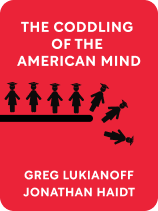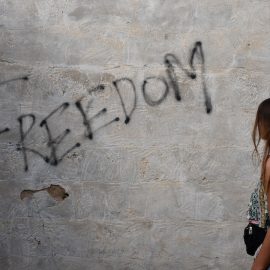

This article is an excerpt from the Shortform book guide to "The Coddling of the American Mind" by Greg Lukianoff and Jonathan Haidt. Shortform has the world's best summaries and analyses of books you should be reading.
Like this article? Sign up for a free trial here .
What is the difference between distributive and procedural justice? How do world events in your teen years help shape your political views?
Authors Jonathan Haidt and Greg Lukianoff describe social justice theories in their book The Coddling of the American Mind. They state that distributive justice means that benefits received should be commensurate with the amount of effort or work one puts in, whereas procedural justice is concerned with fair and transparent rules and processes.
Keep reading to learn more about distributive and procedural justice theories.
Social Justice Theories
Political science research shows that people have a strong tendency to form lasting political views during their teens years and early adulthood. For a certain subset of baby boomers, the experiences of the civil rights movement, the assassinations of Robert F. Kennedy and Martin Luther King, Jr., the Vietnam War, and Watergate shifted their political orientation decisively—and permanently—to the left and to the Democratic Party.
A similar dynamic has taken place with iGen, whose members came of age during the period running roughly from 2008-2017. This was an era of immense social and political turmoil, particularly around questions of identity and racial and gender equity. Some of the events from this era included:
- The election of the nation’s first African-American president
- A growing acceptance of LGBTQA rights, culminating in the Supreme Court’s landmark 2016 Obergefell V. Hodges decision that fully legalized same-sex marriage
- A spate of killings of unarmed black men at the hands of police officers, sparking the Black Lives Matter movement
- The rise of the #MeToo movement, which has exposed the culture of sexual assault within America’s leading political, social, and economic institutions
Amplified by social media, these movements for justice and equity led by people of historically marginalized groups have profoundly influenced young people’s notions of fairness. Young people today are highly skeptical of traditional racial, gender, and class hierarchies.
Two Theories of Justice
Before we delve more deeply into evolving norms of justice and equity, it’s worth exploring how people in a liberal democracy like the United States have customarily understood these concepts. There are two main theories of justice: distributive justice and procedural justice.
Distributive Justice
Distributive justice is centered around the idea that rewards or benefits received ought to be commensurate with the amount of effort or work one puts in.
If someone is under-compensated relative to their labor, this constitutes a violation of distributive justice; a violation likewise occurs when someone is overcompensated for putting in no effort.
Much of this is rooted in what social psychologists call equity theory—that people will intuitively judge an outcome to be fair if the ratio of outcomes to inputs is equal for all participants. Thus, something like unequal pay for equal work (as when women are paid 70 cents for every dollar earned by a man doing the same job) offends our sense of distributive justice.
Procedural Justice
On the other hand, procedural justice is concerned with fair and transparent rules and processes.
If rules are vague, arbitrary, or seem to be applied on an unequal basis to different individuals (or to different groups) then it violates our sense of fairness. Social science research shows that people are quite willing to accept outcomes that are disfavorable to them as long as they have confidence that they were given fair consideration and did not suffer any prejudice or discrimination.
Proportional-Procedural Justice
A hybrid model, what we might term “proportional-procedural justice” or “social justice,” holds that society has an obligation to ensure that people are not denied either their fair share (proportional justice) or due process (procedural justice) because of their membership in a minority group or other traditionally disadvantaged class.
Convincing members of the majority group of the merits of this approach to justice can be difficult, especially in a democratic society like the United States, where the majority can always outvote the minority. Even nominally “fair” processes and procedures like free democratic elections and referenda can yield injurious results for the minority, simply by virtue of their numerical inferiority.
Members of the majority must therefore be open to understanding how minorities are disadvantaged, and accept that minorities have inherent rights that are deserving of respect and cannot be revoked by a simple majority vote.
Equality of Opportunity vs. Equality of Outcomes
Clearly, then, social justice and minority rights are important. The overwhelming commitment to rights for LGBTQA people and racial minorities on the part of today’s university students is noble and worthy of celebration.
The trouble arises when these efforts stop focusing on ensuring equal access to opportunities and start focusing on the equality of material outcomes. Such a shift in attitudes toward social justice began before iGen.
Title IX of the 1972 Education Amendments Act was designed to ensure that female athletes at colleges and universities would not face discrimination in their access to varsity athletic programs. But, beginning in the 1990s, the federal government began to change its interpretation of the statute to insist that colleges receiving federal funds had to work to ensure gender-equal outcomes.
New guidelines told schools that the gender composition of their athletic population had to match the gender composition of their overall student population. But because there was not equal interest in athletic programs among men and women, many schools were forced to either cut male athletic programs and/or artificially inflate the rosters for their female athletic programs in order to meet these quotas.
Fair Inequality vs. Unfair Equality
Episodes like this underscore the problems that come from conflating opportunities with outcomes. An excessive fear of groups being overrepresented or underrepresented leads to the imposition of quotas, in which individuals are judged not on their merits, but on their membership in a particular group.
This is an inversion of our aforementioned ideas of justice. Fair inequality is far preferable to unfair equality. Sacrificing someone’s individual rights to achieve some goal of group equity intuitively violates our sense of fairness. This is why most people react negatively to the idea of quotas or mandatory proportional representation.
Just as correlation does not mean causation, unequal outcomes do not necessarily mean that there is some underlying injustice. Forcibly pursuing equal outcomes at the expense of individual rights alienates potential allies and ultimately works against the goals of social justice.

———End of Preview———
Like what you just read? Read the rest of the world's best book summary and analysis of Greg Lukianoff and Jonathan Haidt's "The Coddling of the American Mind" at Shortform .
Here's what you'll find in our full The Coddling of the American Mind summary :
- The "three Untruths" that have taken hold of young people
- The damage that "speech codes" cause on college campuses
- How colleges are increasingly seeing students as customers






